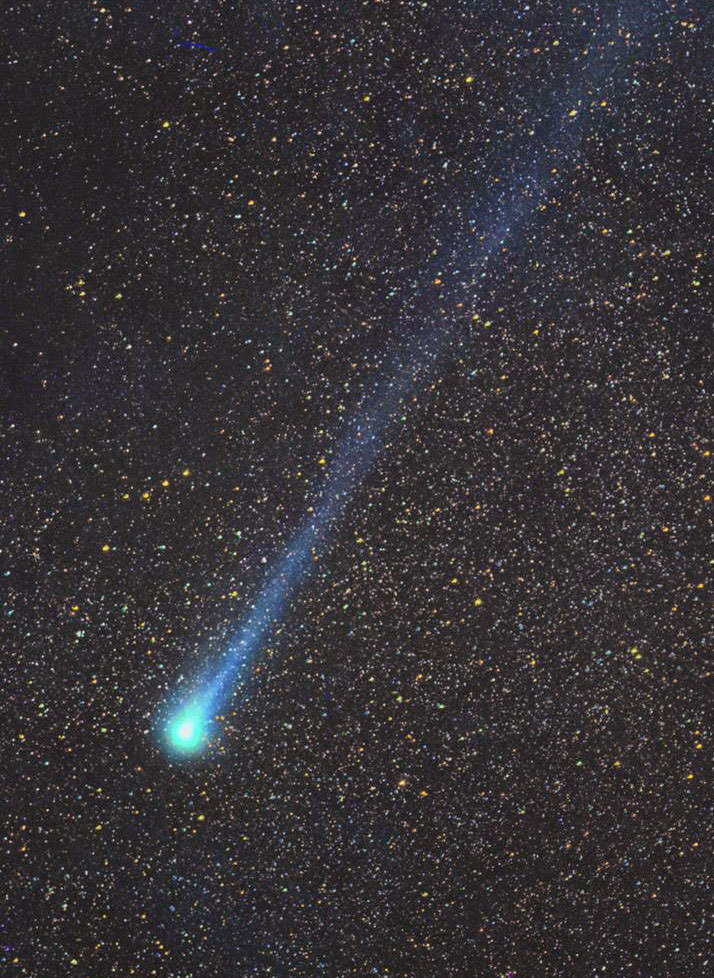A new theory suggests that Titan’s majestic dune fields may have come from outer space. Researchers had always assumed that the sand making up Titan’s dunes was locally made, through erosion or condensed from atmospheric hydrocarbons. But researchers from the University of Colorado want to know: Could it have come from comets?
The dunes of Titan
When the Cassini spacecraft arrived in orbit around Saturn, nobody had ever seen beneath the thick soupy atmosphere of Titan. So when it dropped the Huygens lander, and began probing Titan with cloud-penetrating radar, scientists were surprised to learn that Titan has a very earth-like appearance. It has a thick nitrogen atmosphere, rain, rivers, oceans and massive dune fields. But unlike the dunes of Earth’s sandy deserts in Namibia and southern Arabia, Titan’s dunes are enormous, and fill massive fields covering more than an eighth of the giant moon’s surface. These dunes are about 100 meters tall, 1 to 2 km wide at the base, and can stretch for hundreds of kilometers in length.
Dunes on Earth are made from sand, which is blown by the wind and heaped into drifts. Individual sand particles are nudged and blown by the wind with enough force to make them bounce and scatter in a process called saltation. If the particles don’t bounce, then they cannot pile up on top of each other, but if the wind is able to lift them off the ground completely then they simply blow away. Saltation depends on the size and mass of the sand particles and the strength of the wind, but also needs the particles to be dry so that they can move freely without sticking together.
Titan’s geology
Titan is the second largest moon in the entire Solar System, beaten only by Ganymede, orbiting Jupiter. It is Saturn’s largest moon, and very old. Unlike most of Saturn’s moons, which were captured over time, Titan would have formed together with Saturn billions of years ago. Despite having so many features in common with Earth, it is a very different place. It is so intensely cold that, instead of water, its rain and rivers are made from liquid hydrocarbons like methane. Water, on the other hand, is frozen into hard ice; rocks on Titan are made from water ice, instead of granite and basalt, and Titan’s equivalent of lava and magma are made from liquid water and ammonia.
This means that sand on Titan is not made from silica eroded from larger rocks, since those materials are not found on the surface. One popular theory is that it could instead be made from ice. When liquid methane rains and flows, it could erode the water-ice bedrock, grinding chunks together to a sand of ice grains. An alternative idea is that the sand particles are instead made from tholins. These are found all over the colder regions of the Solar System, where cold hydrocarbons in comets or the outer atmospheres of planets and moons react with ultraviolet light from the Sun to create complex compounds. Tholins formed in the dry atmosphere of Titan could clump together with static electricity to form small grains of soot that then settle to the ground, creating both dust and sand.

What do comets have to do with this?
A paper presented at this year’s Lunar and Planetary Science Conference (LPSC) suggests a new idea: What if the sand came from comets? Comets, as we know, are made from materials left over from the creation of the Solar System. Most of the primordial gas and dust that collapsed from an ancient nebula to form the Solar System would have ended up in the Sun, with the bulk of the remains forming the planets. But this would still have left a lot of material floating free, and some of that would have gradually coalesced into lumps of dust and ice, which we see today as comets. When comets are nudged into elliptical orbits and pass through the inner Solar System, some of their ice heats up and sublimates into gas which blows out, carrying dust with it. This dust is scattered throughout the Solar System, concentrated along the various comet’s orbits. Individual grains often collide with the Earth, which we see as meteors, burning high in our atmosphere. Recent surveys in Antarctic ice fields, where there is no surface sand, have found many such particles which have survived atmospheric reentry.
But Earth is not the only place where these grains can end up. According to the researchers, there was a time when a great many comets were passing close by Saturn and its moons. They ran simulations to study the evolution of the Kuiper Belt, using a version of the Nice model. The Nice model, named for the city in which it was first presented, says that the Solar System was originally arranged very differently from how it is today. Over time, the planets migrated to their current locations. During this period, Neptune passed through the Kuiper belt, nudging many comets into new orbits. Many of these comets passed close by Saturn and its moons, and some even collided with the moons. The researchers suggest that much of the sand making up Titan’s dunes may be debris from all these comets.

Credit: NASA/Johns Hopkins APL/Steve Gribben
But is it true? This idea does fit with what we currently know, and is supported by computer modelling, but so do the other theories. Fortunately, NASA recently confirmed that the Dragonfly mission will be launched in July 2028. Dragonfly is a lander, which will be sent to Titan. But unlike previous missions, this one is an 8-rotor flying drone. Like the rovers on Mars, it will be able to move to any areas of interest that scientists would like to study further. When it arrives in 2034, it will fly to dozens of locations on Titan’s surface, and should settle the question once and for all: Are the dunes of Titan really built from comet dust?

